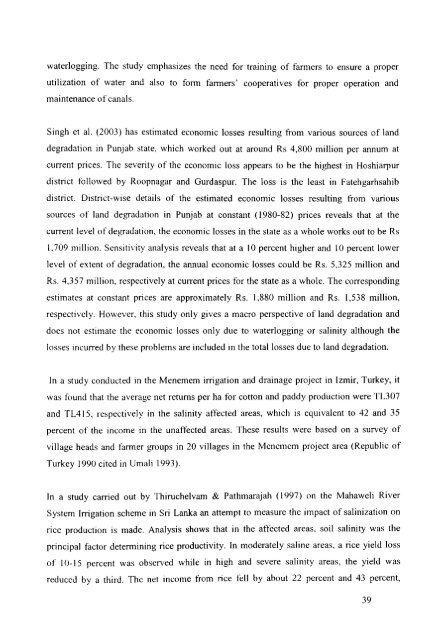Water Users Association and Irrigation Management - Institute for ...
Water Users Association and Irrigation Management - Institute for ...
Water Users Association and Irrigation Management - Institute for ...
You also want an ePaper? Increase the reach of your titles
YUMPU automatically turns print PDFs into web optimized ePapers that Google loves.
waterlogging. The study emphasizes the need <strong>for</strong> training of farmers to ensure a proper<br />
utilization of water <strong>and</strong> also to <strong>for</strong>m farmers' cooperatives <strong>for</strong> proper operation <strong>and</strong><br />
maintenance of canals.<br />
Singh et al. (2003) has estimated economic losses resulting from various sources of l<strong>and</strong><br />
degradation in Punjab state, which worked out at around Rs 4,800 million per annum at<br />
current prices. The severity of the economic loss appears to be the highest in Hoshiarpur<br />
district followed by Roopnagar <strong>and</strong> Gurdaspur. The loss is the least in Fatehgarhsahib<br />
district. District-wise details of the estimated economic losses resulting from various<br />
sources of l<strong>and</strong> degradation in Punjab at constant (1980-82) prices reveals that at the<br />
current level of degradation, the economic losses in the state as a whole works out to be Rs<br />
L 709 million. Sensitivity analysis reveals that at a 10 percent higher <strong>and</strong> 10 percent lower<br />
level of extent of degradation, the annual economic losses could be Rs. 5,325 million <strong>and</strong><br />
Rs. 4,357 million, respectively at current prices <strong>for</strong> the state as a whole. The corresponding<br />
estimates at constant prices are approximately Rs. 1,880 million <strong>and</strong> Rs. 1,538 million,<br />
respectively. However, this study only gives a macro perspective of l<strong>and</strong> degradation <strong>and</strong><br />
does not estimate the economic losses only due to waterlogging or salinity although the<br />
losses incurred by these problems are included in the total losses due to l<strong>and</strong> degradation.<br />
In a study conducted in the Menemem irrigation <strong>and</strong> drainage project in Izmir, Turkey, it<br />
was found that the average net returns per ha <strong>for</strong> cotton <strong>and</strong> paddy production were TL307<br />
<strong>and</strong> TL415, respectively in the salinity affected areas, which is equivalent to 42 <strong>and</strong> 35<br />
percent of the income in the unatTected areas. These results were based on a survey of<br />
village heads <strong>and</strong> farmer groups in 20 villages in the Menemem project area (Republic of<br />
Turkey 1990 cited in Umali 1993).<br />
In a study carried out by Thiruchelvam & Pathmarajah (1997) on the Mahaweli River<br />
System <strong>Irrigation</strong> scheme in Sri Lanka an attempt to measure the impact of salinization on<br />
rice production is made. Analysis shows that in the affected areas, soil salinity was the<br />
principal factor determining rice productivity. In moderately saline areas, a rice yield loss<br />
of 10-15 percent was observed while in high <strong>and</strong> severe salinity areas, the yield was<br />
reduccd by a third. Thc net income from rice fell by about 22 percent <strong>and</strong> 43 percent,<br />
39
















